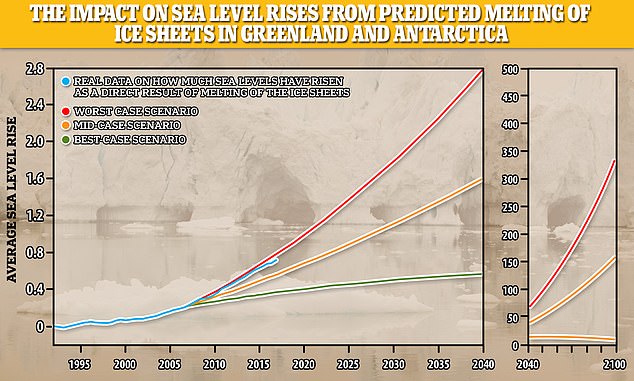
**New Climate Models Indicate Rapid Greenland Ice Decline: Implications for Global Sea Levels**
As global society confronts the implications of climate change, Greenland’s vast ice sheet has surfaced as a significant indicator of global warming and a key factor in the anticipated rise of sea levels. A recent study published in *Geophysical Research Letters* has illuminated concerning forecasts for Greenland’s future, indicating that the rate of ice loss by 2100 may reach up to twice the earlier assessments, contingent upon the specific climate model utilized. These results elevate the urgency surrounding the comprehension of ice sheet behaviors and the impact of a warming Earth.
Under the leadership of Dr. Q. Glaude from the University of Liège, an international team of scientists evaluated projections derived from three leading regional climate models – RACMO, MAR, and HIRHAM – within the high-emission scenario SSP5-8.5. Their analysis revealed a dramatic variance in predictions, estimating annual ice loss by century’s end at between 964 gigatonnes (Gt) and 1,735 Gt. This fresh research highlights significant deficiencies in our grasp of processes like meltwater runoff and surface mass balance, which greatly affect the velocity of Greenland’s ice depletion.
### **Greenland’s Ice Reduction: Model Insights**
All three models forecast considerable ice reduction amid ongoing climate warming, yet variations in their assumptions and methodologies lead to substantial discrepancies in their projections. Noteworthy findings include:
– The MAR model predicts that by 2080-2099, 70% of Greenland’s ice sheet surface will shift into the ablation zone (where ice loss surpasses accumulation).
– The HIRHAM model presents a more daunting scenario, anticipating that 87% of the surface may undergo net mass loss.
– RACMO provides a more cautious forecast, indicating that 47% of the surface will turn into an ablation zone.
These differences stem from diverse methodologies in modeling meltwater runoff, particularly regarding how each model considers the retention of meltwater within the ice sheet compared to its direct drainage into the ocean. Variations in sensitivity to warming and feedback loops, such as the melt-albedo feedback, add to the array of obtained results.
### **The Escalating Influence of Precipitation**
Interestingly, all three models converge on one aspect: a notable surge in precipitation across Greenland. By 2100, snowfall is expected to increase by 200-250 Gt annually, contributing additional mass to the ice sheet. However, this rise is inadequate to offset the growing losses from surface melting and runoff.
As temperatures ascend, the ice sheet’s capacity to hold meltwater weakens, leading to greater volumes of water flowing directly into the ocean and hastening sea level rise.
### **Feedback Mechanisms Amplifying Ice Loss**
A particularly concerning facet of Greenland’s melting dynamics lies in feedback mechanisms that heighten warming impacts. As the ice sheet decreases, darker surfaces such as meltwater ponds and exposed rock become visible. These surfaces absorb more solar energy than ice and snow, elevating local temperatures and prompting further melting in a self-perpetuating cycle. Referred to as the melt-albedo feedback, this phenomenon is notably strong in models indicating higher ice loss.
Adding to the complexity is the role of firn, a porous layer situated between new snow and glacial ice. Firn can store meltwater and refreeze it, providing a temporary postponement of runoff. However, the rate of firn transitioning into denser, less porous ice differs across models, affecting runoff predictions.
### **Global Consequences of Greenland’s Ice Decline**
The ramifications of Greenland’s accelerating ice loss are far-reaching and significant. Currently, the ice sheet accounts for 25% of the global sea level rise, translating to about 0.6 mm per annum. Should the upper loss estimates hold true, Greenland’s impact on rising seas could escalate dramatically, endangering coastal communities and ecosystems worldwide.
Should Greenland’s ice sheet fully melt, it possesses enough water to elevate global sea levels by over 7 meters. While such a catastrophic event is not predicted to occur imminently, even slight increases in melting rates could yield serious outcomes, particularly for low-lying nations and urban areas already facing higher water levels and increased flooding.
### **The Urgent Need to Enhance Climate Models**
A vital conclusion from this research is the necessity to enhance climate models for improved projections regarding Greenland’s future. Researchers, including climatologist Xavier Fettweis, emphasize that while all models indicate an urgent issue, the differences in their forecasts reveal a lack of understanding regarding ice sheet mechanisms.
Enhanced data collection, refined modeling of firn processes, and more nuanced simulations of meltwater behavior are essential for reducing uncertainties surrounding Greenland’s future contributions to sea level rise. Addressing these gaps will empower policymakers to better prepare for the repercussions of climate change and protect vulnerable populations from increasing hazards.
### **Fostering Resilience in an Uncertain Future**
With Greenland’s ice loss accelerating at an unforeseen pace, the